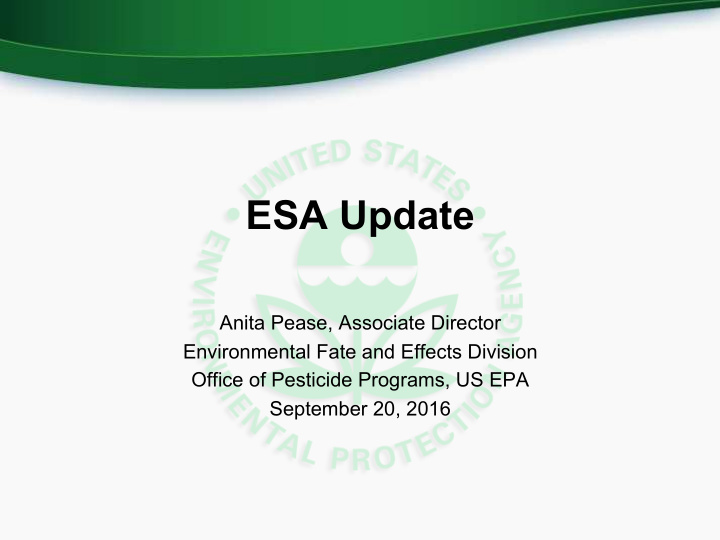



ESA Update Anita Pease, Associate Director Environmental Fate and Effects Division Office of Pesticide Programs, US EPA September 20, 2016
Today’s Topics • Interagency Process Agreements • Draft Biological Evaluation (BE) Summary and Tools • Draft BE Comments • Path Forward 2
Interagency Process Agreements • Shared interagency approach • All agencies open to changing methodology • Development of interim methods – Data, tool, and models used in Steps 1 and 2 inform Step 3 – Consider stakeholder input • Revise interim method based on lessons learned and application of scientific approaches • Once vetted, day-forward approach and 3 iterative
Draft BE Summary • Draft BEs for chlorpyrifos, diazinon, and malathion released on April 6, 2016 – https://www.epa.gov/endangered-species/implementing- nas-report-recommendations-ecological-risk- assessment-endangered-and – Instructions for commenting – 60-day public comment period • Scale and Scope – First nation-wide ESA BEs using interim methods – Steps 1 and 2 are at the individual level – Is the pesticide “ likely to adversely affect ” (LAA) or “ not likely to adversely affect ” (NLAA) an individual of a listed species? 4
Draft BE Summary • Step 1 – Overlap of action area with species range and/or critical habitat – Is there potential for direct and/or indirect effects from the action? – No Effect / May Affect determination • No Effect – no consultation necessary • May Affect – move to Step 2 6
Draft BE Summary • Step 2 – Weight-of-Evidence Approach • Lines of evidence • Estimating exposures (in aquatic and terrestrial habitats) • Effects thresholds (direct and indirect effects) • Incident data • Qualitative discussion of mixtures and abiotic influence on toxicity – Is an individual’s fitness reduced or are species’ essential habitat features affected? – LAA / NLAA determination • LAA – move to Step 3 (jeopardy determination) 7 • NLAA – concurrence from Services
Draft BE Summary Weight-of-Evidence Approach 8
New Tools • New tools developed to improve efficiency, manage large volume of data, and ensure consistency and transparency • Exposure – Pesticide Water Calculator (PWC) Automation Tool and PWC post processor • New ESA scenarios developed – Terrestrial Effects Determination (TED) Tool 12
New Tools • Effects – Data Array Builder – Species Sensitivity Distribution (SSD) Toolbox • Risk – Weight-of-Evidence Matrix Generators – Refined risk models for birds (TIM and MCnest) 13
10
Species Sensitivity Distribution 11
Draft BE Summary • LAA for most listed species – 97% for chlorpyrifos and malathion – 80% for diazinon – Due to overlap of range/critical habitat and potential uses sites – Low thresholds (high toxicity), maximum use rates, other assumptions of exposure – Weight-of-evidence approach – Higher degree of confidence in LAA calls for some taxa (e.g., invertebrates, birds) – LAA for single individual of a listed species 11
Draft BE Comments • Public comments – >78,000 comments; 120 substantive • 2-day ESA Stakeholder Workshop in June 2016 – Aquatic Modeling – Spatial and non-spatial refinements to Steps 1 and 2 – Weight-of-evidence analysis for animals and plants – https://www.epa.gov/endangered-species/5th-esa- workshop-joint-interim-approaches-nas- recommendations 11
Path Forward • Final BEs for chlorpyrifos, diazinon, and malathion and Response to Public Comments (including consideration of recommendations from ESA Stakeholder workshop): – December 2016 • Continued work on draft BEs for carbaryl and methomyl: – Spring 2017 • Continued work on Step 3 (BiOp) interim method: – 3-day interagency workshop in September 2017 – Draft BiOps for chlorpyrifos, diazinon, and malathion in May 2017 • Final BiOp dates: – December 2017: chlorpyrifos, diazinon, and malathion – December 2018: carbaryl and methomyl • Next 4: atrazine, simazine, propazine, and glyphosate 16 (2020-2022)
Questions? 18
Recommend
More recommend